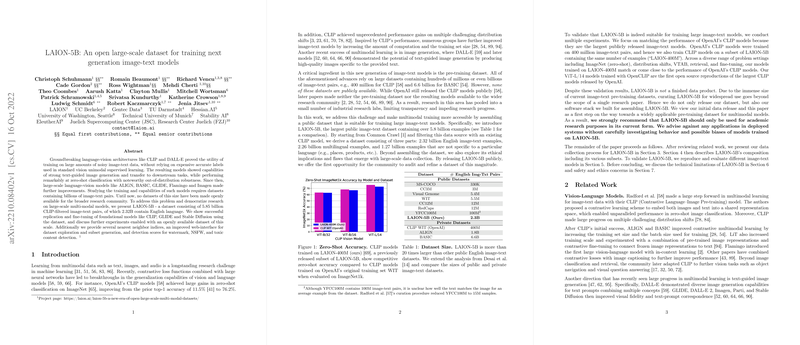LAION-5B: An Open Large-Scale Dataset for Training Next Generation Image-Text Models
The paper introduces LAION-5B, a significant open-source contribution to the research community that aims to democratize access to large-scale datasets required for training state-of-the-art multimodal models. This dataset comprises 5.85 billion image-text pairs filtered by a CLIP model, offering researchers a valuable resource to advance the development and evaluation of language-vision systems.
Introduction and Context
The rapid advancements in multimodal learning, exemplified by models such as CLIP and DALL-E, have illustrated the profound impact of training on massive datasets. These models achieve remarkable performance on zero-shot tasks and exhibit exceptional robustness to distribution shifts. However, the datasets used to train these models, often containing billions of image-text pairs, have generally been proprietary and thus inaccessible to the broader research community. LAION-5B addresses this gap by providing a publicly available, large-scale image-text dataset, enabling transparent and reproducible research.
Dataset Composition
LAION-5B is segregated into three subsets: 2.32 billion English image-text pairs, 2.26 billion multilingual pairs, and 1.27 billion pairs where language detection was inconclusive. This categorization allows for targeted research on various linguistic and application-specific tasks. The dataset also includes metadata such as image URLs, text, dimensions, and cosine similarity scores.
Data Curation and Filtering
The dataset was constructed from Common Crawl, leveraging metadata and alt-text from HTML IMG tags. The filtering process employed OpenAI's ViT-B/32 CLIP model to select image-text pairs with a cosine similarity above predefined thresholds, ensuring a higher quality of semantic alignment between images and texts. Additionally, safety and ethical considerations were incorporated, tagging images with attributes such as NSFW content and watermarks to facilitate responsible usage.
Validation Through CLIP Reproduction
To validate the utility of LAION-5B, the paper presents extensive experiments replicating CLIP-like models. Using OpenCLIP, multiple architectures, including ViT-B/32, ViT-B/16, ViT-B/16+, and ViT-L/14, were trained on LAION-400M and LAION-2B-en subsets. The models demonstrated competitive performance compared to the original CLIP models across various zero-shot classification benchmarks like ImageNet-1k, ImageNet-A, and others. Stronger models, trained on larger subsets, showed improved transfer and robustness performance, indicating the beneficial impact of dataset scale and model size.
Generative Model Fine-Tuning
Experiments were also conducted with generative models such as GLIDE and Stable Diffusion. Fine-tuning OpenAI's pre-trained GLIDE on LAION-5B resulted in models capable of generating high-quality images, demonstrating the dataset's efficacy for training state-of-the-art text-to-image models. These results further validate LAION-5B's potential to support diverse research directions within multimodal learning.
Ethical Considerations
The paper underscores the ethical imperatives associated with deploying large-scale datasets. While LAION-5B offers unprecedented access to vast multimodal data, it simultaneously inherits potential biases from its sources and filtering algorithms. Mitigating these biases by tagging inappropriate content is a step toward responsible usage, though the authors strongly advocate for academic use only and caution against deploying models trained on LAION-5B without comprehensive bias and safety evaluations.
Implications and Future Directions
The implications of LAION-5B extend beyond immediate academic research. By providing a large-scale, openly accessible dataset, it paves the way for community-driven advancements in multimodal learning, enabling researchers to build and test robust models without proprietary constraints. Future work includes curating more refined subsets using larger CLIP models and exploring the dataset's potential for applications in low-resource languages and ethnically diverse contexts.
In summary, LAION-5B significantly advances the accessibility of large-scale datasets for the broader research community. It facilitates the development and evaluation of robust, state-of-the-art multimodal models while laying a foundation for ethical and transparent research practices in AI.
